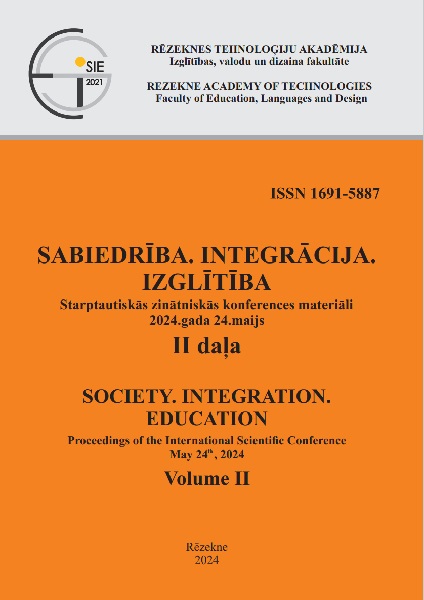WELL-BEING AND WORK SPECIFICS FOR FITNESS TRAINERS IN LATVIA
DOI:
https://doi.org/10.17770/sie2024vol2.7911Keywords:
fitness trainers, health issues, injuries, well-being, work specificsAbstract
The work-related load can cause serious health issues and discomfort. Ligament and muscle sprains and inflammations, psycho-emotional issues, burnout, and other problems among trainers are not treated in due course and contribute to the inability to work in the future. The profession of a fitness trainer is quite challenging – heavy workload, highly changing environment, noise, the risk factors, high responsibility, high flow of people, high competition, and a relatively low salary. Every day, fitness trainers help others to improve their health and appearance. However, trainers often forget about how much the specifics of their work can harm themselves. Therefore, the purpose of this study is to investigate the work specifics of fitness trainers and how it affects the well-being of trainers in Latvia. An anonymous online survey was conducted to achieve this goal. The survey consisted of 26 closed-ended questions with multiple-choice answers and the possibility to add one’s own response option. The survey was divided into blocks, namely qualification and work experience, work specifics and conditions, rest and recovery, and characteristics of well-being. In total, 141 fitness trainers from Latvia participated in the study, of which 92 were women and 49 were men. For data analysis, the SPSS 18.0 software was used for performing mathematical and descriptive statistics. Analysing the obtained results, it can be concluded that fitness trainers in Latvia have a very heavy workload on a daily basis, there is practically no opportunity to rest and recover between the training sessions, there are very few or no days off at all, there is often no time and energy to fully and qualitatively focus on one’s own body and physical form, and often there are no regular visits to qualified specialists who could help trainers to improve their own well-being. All of this contributes to the discomfort, pain, and ill health among fitness trainers on a daily basis. Therefore, this issue needs to be addressed at the industry level.
References
Bonato, M., Merati, G., Agnello, L., Grevers, D. (2020). Occupational injuries, daily workload, and fitness levels among fitness and swimming instructors. Retrieved from: https://www.researchsquare.com/article/rs-16496/v4
Bratland-Sanda, S., Sundgot-Borgen, J., & Myklebust, G. (2015). Injuries and musculoskeletal pain among Norwegian group fitness instructors. European journal of sport science, 15(8), 784-792. Retrieved from: doi: 10.1080/17461391.2015.1062564
George, S. A., & Abraham, A. T. (2022). A Review on Musculoskeletal Pain and Injuries among Fitness Instructors. Int J Health Sci Res, 7(2), 150-156. Retrieved from: https://doi.org/10.52403/ijshr.20220422
Gjestvang, C., Bratland-Sanda, S. & Mathisen, T.F. (2021). Compulsive exercise and mental health challenges in fitness instructors; presence and interactions. J Eat Disord 9, 107. Retrieved from: https://doi.org/10.1186/s40337-021-00446-0
Klimek, C., Ashbeck, C., Brook, A.J., Durall, C. (2018). Are Injuries More Common With CrossFit Training Than Other Forms of Exercise? Journal of Sport Rehabilitation, 27, 295-299. Retrieved from: https://doi.org/10.1123/jsr.2016-0040
Malliou, P., Rokka, S., Tsiganos, G., Mavromoustakos, S., & Godolias, G. (2013a). Dance aerobic instructors' injuries in relation to external risk factors, part II. Journal of Human Sport and Exercise, 8(3), 813-819. Retrieved from: doi: 10.4100/jhse.2013.83.06
Malliou, P., Rokka, S., Tsiganos, G., Mavromoustakos, S., & Godolias, G. (2013b). Profile of dance aerobic instructors' injuries, part I. Journal of Human Sport and Exercise, 8(3), 806-812. Retrieved from: doi: 10.4100/jhse.2013.83.05
Malliou, P., Rokka, S., Beneka, A., Gioftsidou, A., Mavromoustakos, S., & Godolias, G. (2014). Analysis of the chronic lower limb injuries occurrence in step aerobic instructors in relation to their working step class profile: a three year longitudinal prospective study. Journal of Back and Musculoskeletal Rehabilitation, 27(3), 361-370. Retrieved from: doi: 10.3233/BMR-140456
Shinde, N., & Sahasrabuddhe, P. (2021). Prevalence of musculoskeletal pain and injuries in gym instructors. Int J Health Sci Res, 11, 62-7. Retrieved from: https://doi.org/10.52403/ijhsr.20210408
Stephen, K., Van Woerden, H., & MacRury, S. (2019). Assessing prevalence of urinary incontinence in Scottish fitness instructors and experience of teaching pelvic floor muscle exercises: an online survey. Journal of Public Health, 41(1), e44-e50. Retrieved from: doi:10.1093/pubmed/fdy102






